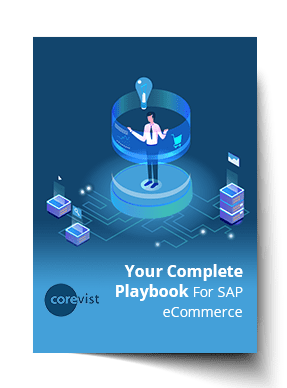Share
Author
George Anderson
Share
Last updated January 28, 2021.
In a recent study of 143 European manufacturers, Copperberg, a Danish research firm, uncovered some startling insight. They asked respondents how many team members within the company were dedicated to ecommerce. The answers played out like this (go download the survey for the full picture):
- 1-4 employees—38%
- 5-9 employees—19%
- 10+ employees—43%
The survey concludes that there is a clear split here in how these manufacturers are approaching ecommerce. Copperberg sums up the situation this way: “It seems that ecommerce right now really is an all-in-or-nothing approach.”
Why do so many manufacturers feel this way? We’d like to suggest it’s because they face 3 major barriers to entry.
In this article, we’ll talk about those barriers to entry, plus our ideas on how to deal with each one.
Barrier 1: Don’t want to become a technology company
The responses in Copperberg’s survey aren’t all that surprising. Not all manufacturers can justify an ecommerce team of 10+ employees. After all, with an ecommerce department that big, you’ve essentially become a technology company in addition to your primary business as a manufacturer.
NEW Guide:
Your Complete Playbook for SAP eCommerce
Here are 4 keys to successful eCommerce channel in an SAP ERP scenario.
Not convinced this is a real barrier? Keep this in mind: Forrester has reported that SAP hybris/Commerce Cloud requires 12 full-time employees to maintain. And while SAP hybris is on the high end of the spectrum in that regard, it’s illustrative of the problem facing manufacturers.
The Alternative: Engage A Managed Solution Provider
If you don’t want to build a large in-house ecommerce team, you should look at managed solutions. Believe it or not, these do exist for manufacturers running SAP. The Corevist Platform, our fully managed solution, includes the platform, implementation/integration, support, and more. We manage your web channel so you can focus on your business. Read more here: The Corevist Difference.
Barrier 2: Don’t want to coordinate multiple vendors to deal with the complexity
B2B ecommerce isn’t a simple proposition for manufacturers. Because business data lives in SAP, the ecommerce platform needs to interact with SAP in real time to provide a workable user experience.
Since most ecommerce platforms aren’t built with SAP in mind, manufacturers find themselves in a tough spot: no one is covering all the bases. The ecommerce platform vendor will sell the platform—but it doesn’t include integration out of the box. Middleware providers offer solutions—but they’ll introduce a third system into the equation which greatly complicates maintenance and troubleshooting.
The Alternative: Engage A Managed Solution That Includes Prebuilt, Configurable SAP Integration
A managed solution with prebuilt SAP integration offers great value for manufacturers who can’t justify the hassle of coordinating multiple vendors. When you engage a solution like this, you get “one throat to choke” for all things ecommerce. Rather than spending millions to build SAP integration from scratch, you leverage a prebuilt, real-time interface that’s configurable to your needs.
In other words, the solution provider handles your web channel so you can focus on your business. For more info, check out the Corevist Platform.
Barrier 3: Unsure how to compete online
The first two roadblocks we mentioned are technical, but this problem is strategic. Manufacturers who haven’t fully owned their web presence, or who have no ecommerce experience at all, may feel intimidated by the prospect of defining their digital strategy—let alone their digital goals.
Unfortunately, leaving things undefined is no longer an option. With the rise of Amazon Business and more and more manufacturers launching their own branded web channels, it’s imperative that manufacturers define their online presence.
Luckily, we’ve got plenty of places to start. Check out these articles for more:
- What % Of Overall Revenue Do You Want To Flow Through Ecommerce?
- Amazon, Branded B2B Web Channel, Or Both?
- Top Trends in B2B Ecommerce Strategy
Footnote: Selling 3rd party products
It’s worth noting that only 18% of respondents to Copperberg’s survey said they sell 3rd party products in addition to their own products. As we’ve covered elsewhere, it’s essential that every manufacturer evaluate the idea of selling 3rd party products to see if there’s an opportunity there. In many markets, selling ancillary products alongside your own manufactured major products makes you more valuable to the customer. When they don’t have to visit multiple web stores to get everything they need, you make their lives easier, which also makes your web channel “stickier.”
The Solution: Engage A Trusted Web Channel Advisor
The digital world changes fast, and it’s no wonder manufacturers struggle to define their strategy. That’s part of why Corevist exists. Not only do we provide the platform, the implementation, and support, but we also consult with you on the present state of your web channel (and where it’s headed). That way, you keep tracking to your ecommerce goals.
NEW Guide:
Your Complete Playbook for SAP eCommerce
Here are 4 keys to successful eCommerce channel in an SAP ERP scenario.










